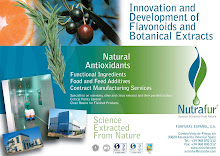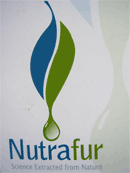They are many and diverse the products manufactured by Nutrafur-Furfural Español that can be considered as functional ingredients: extracts from citrus, olive tree, rosemary, sage, thyme, camomile, etc... Inside this wide range of plant extracts and polyphenolic compounds of high concentration they highlight the following ones: rich olive tree extracts in oleuropein and/or hydroxytyrosol, the denominated "citrus bioflavonoid complex", grapefruit extracts and bitter orange with high flavonoid concentrations and both water-soluble compounds and flavone apigenin, obtained starting from citrus species and, finally, diverse specific extracts from rosemary leaves with high concentration of rosmarinic acid, mainly, carnosic acid, with concentrations of until 70-80% of this diterpene.
The aplications of most of our products in this field are related with their capacity to "protect" the cardiovascular system, as "vasoprotective and venotonic agents". This fact is based in two of its main properties: their capacity like specific antioxidant and as anti-inflammatory. Simultaneously, we have developed products, very defined chemically, for more specific applications: the inhibition of the oxidation of LDL cholesterol, the regulation of the plasmatic levels of triglycerides, until the protective activity against the ageing effects of the solar radiation and other ionizing radiations (photoageing and cellular malignization, including melanomas).
These new developments, together with the necessary technology to obtain water-soluble products with high content in active principles, they have introduced us in the last years in the explicit market of the functional preparations and the new "cosmeceutica". Besides these that we have just mentioned, we are developing specific new compositions dedicated to the regulation of the denominated "metabolic syndrome" obviously related with diverse mal-functions of the metabolic and cardiovascular systems.
Will it affect us somehow the future regulation of Nutritional Declarations?. In general anything, is more, for Nutrafur any increment in the regulation demands for the incorporation of these ingredients and the demonstration of their effectiveness, it is interesting. The philosophy of our company is the one of developing compound very well defined chemically, to characterize its actives and properties, including a good chemically, to characterize its actives and properties, including a good number of studies and scientific publications, establishing this way a correct relationship between the product and its capacity to "be healthy".

